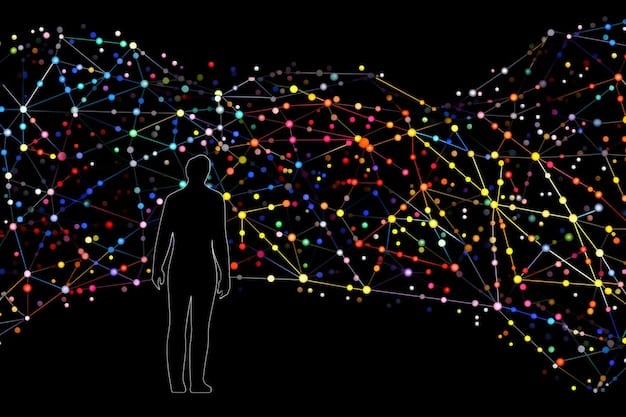Social Media Algorithms Fueling US Polarization: The Dark Side Unveiled

Social media algorithms, designed to maximize engagement, inadvertently create echo chambers and amplify extreme viewpoints, significantly contributing to political and social polarization within the United States.
In our increasingly digital world, social media platforms have become ubiquitous, fundamentally reshaping how we connect, share information, and form opinions. However, beneath the veneer of interconnectedness lies a complex mechanism engineered to hold our attention: the algorithm. This powerful, often opaque, force plays a central role in The Dark Side of Social Media: How Algorithms Are Fueling Polarization in the US, subtly influencing our perception of reality and exacerbating societal divisions.
The Algorithmic Echo Chamber: Reinforcing Pre-existing Beliefs
One of the most insidious effects of social media algorithms is the creation of what are commonly referred to as “echo chambers” or “filter bubbles.” These digital enclaves, where individuals are predominantly exposed to information and viewpoints that align with their existing beliefs, are not accidental byproducts but direct consequences of how algorithms prioritize content.
The core function of an algorithm, from a platform’s perspective, is to maximize user engagement. This means feeding users more of what they already like, click on, share, and spend time viewing. If a user frequently interacts with content expressing a particular political ideology, the algorithm will subsequently present more of that type of content, reinforcing their existing worldview and limiting exposure to dissenting opinions. This creates a self-perpetuating cycle where users are less likely to encounter, let alone engage with, perspectives that challenge their own.
Understanding the Mechanism of Reinforcement
The design principles behind these algorithms are deceptively simple yet profoundly impactful. They operate on vast datasets of user behavior, identifying patterns and predicting what content will resonate. This predictive power, while seemingly benign, leads to a highly personalized information diet that can become increasingly narrow over time. It’s a feedback loop, where every like, share, and comment fine-tunes the algorithm to deliver more of the same. This personalized feed, while making the user experience feel more relevant, inadvertently silos individuals into ideological islands.
Key elements contributing to this reinforcement include:
- Content Filtering: Algorithms prioritize content based on past engagement, pushing similar material to the top of a user’s feed.
- Connection Suggestions: Platforms suggest following accounts or joining groups that share similar interests, further solidifying the echo chamber.
- Engagement Metrics: Content that generates high levels of interaction (likes, shares, comments) is boosted, regardless of its factual accuracy or polarizing nature.
The challenge arises when these chambers become so robust that they stifle intellectual curiosity and critical thinking. When individuals are constantly affirmed in their beliefs, they may develop a reduced capacity for empathy or understanding towards those with different viewpoints, seeing them as inherently wrong rather than simply different.
The continuous reinforcement of pre-existing beliefs through algorithmic echo chambers poses a significant threat to democratic discourse. It hinders genuine dialogue and mutual understanding, replacing it with confirmation bias and an amplified sense of “us vs. them.”
The Amplification of Extremism and Misinformation
Beyond creating echo chambers, social media algorithms also have a documented tendency to amplify extreme content, conspiracy theories, and misinformation. This phenomenon is driven by the very metrics algorithms are designed to optimize: engagement. Highly emotional, sensational, or contentious content often generates more clicks, shares, and comments than nuanced or balanced information, making it more likely to be promoted across platforms.
Research has consistently shown that content that evokes strong emotions—whether anger, fear, or outrage—tends to spread faster and wider on social media. Algorithms, in their pursuit of maximizing engagement, effectively act as accelerants for this type of material. This means that fringe ideas or extremist views, which might otherwise struggle to gain traction in traditional media landscapes, can find immense reach and influence online, distorting public perception and radicalizing individuals.
How Algorithms Boost Extremist Narratives
The pathways through which algorithms amplify extremism are multifaceted. One common mechanism is the “rabbit hole” effect on platforms like YouTube, where recommended videos can lead users down increasingly extreme content pathways, often starting from seemingly innocuous subjects. Another is the viral spread of misinformation, which often outcompetes factual content because it’s designed to be emotionally resonant or confirm existing biases.
The platforms themselves, by prioritizing engagement, create an inherent bias towards content that is polarizing. If an algorithm identifies that negative or sensational content receives more interactions, it will naturally boost that content. This doesn’t necessarily mean the algorithms are “bad” or “evil,” but rather that their objective function (engagement) can have unintended and detrimental societal consequences.
- Sensationalism Over Substance: Content designed to shock or provoke often garners more attention, regardless of factual basis.
- Emotional Resonance: Content appealing to strong emotions like anger or fear performs exceptionally well in algorithmic feeds.
- Speed of Spread: Misinformation, often simplified and emotionally charged, spreads much faster than corrections or factual counter-arguments.
The uncontrolled amplification of misinformation during critical events, such as elections or public health crises, has demonstrably eroded trust in institutions and exacerbated social unrest. When false narratives are presented with the same algorithmic authority as legitimate news, distinguishing truth from fiction becomes an increasingly daunting task for the average user. This environment not only fuels polarization but also undermines the very foundations of a well-informed populace necessary for a functioning democracy.
The Erosion of Shared Reality: Different Truths for Different People
A critical consequence of algorithmic personalization is the fragmentation of a shared reality. Historically, mass media—newspapers, radio, television—provided a relatively common set of facts and narratives that, despite editorial leanings, offered a baseline understanding of public events. Social media, driven by individualistic algorithms, has shattered this collective experience, leading to a landscape where different people effectively inhabit different informational universes.
When individuals are constantly exposed to information tailored to their specific profiles, their understanding of what constitutes “truth” can diverge significantly. This isn’t merely about having differing opinions; it’s about forming beliefs based on fundamentally different sets of “facts” presented by the algorithms. For example, a major news event might be framed entirely differently, or even ignored, across various algorithmic feeds, depending on a user’s perceived interests and political affiliations.
The Disconnect of Digital Realities
This erosion of shared reality makes constructive dialogue and compromise increasingly challenging. If two individuals hold vastly different understandings of fundamental issues, based on the information their algorithms have curated for them, finding common ground becomes nearly impossible. Each person feels justified in their beliefs because their digital environment consistently validates them.
Consider the impact on public discourse on critical issues like climate change, vaccinations, or election integrity. Within their personalized feeds, individuals might be presented with overwhelming “evidence” supporting one side, while their counterparts are shown equally convincing (though often contradictory) “evidence” for the opposite. This creates a deeply fractured society where consensus on even basic facts becomes elusive.
This phenomenon extends beyond political issues. It affects how communities react to local news, how parents make decisions about their children’s education, and even how consumers perceive market trends. Without a shared informational framework, collective action and social cohesion are significantly undermined. The ability to unite around common goals, or even agree on what problems need solving, is severely hampered when perceptions of reality diverge so profoundly.

User Psychology and Algorithmic Exploitation
The efficacy of social media algorithms in fueling polarization is not solely a technical marvel; it also deeply intersects with human psychology. Algorithms are remarkably adept at exploiting inherent human biases and cognitive shortcuts, turning them into levers for engagement. This exploitation isn’t malicious in intent, but rather a consequence of optimizing for attention, regardless of the psychological toll.
One primary bias exploited is confirmation bias, the human tendency to seek out and interpret information in a way that confirms one’s pre-existing beliefs. As algorithms learn these beliefs, they feed into them, creating a reinforcing loop. Another is the negativity bias, where humans tend to give more weight to negative information. Content that expresses outrage or highlights perceived injustices often triggers stronger emotional responses, leading to higher engagement and subsequent algorithmic promotion.
The Compounding Effect of Online Behavior
The design of social media platforms further compounds these psychological vulnerabilities. Features like infinite scroll, notification systems, and gamified metrics (likes, shares) are specifically engineered to keep users hooked. When combined with algorithms that constantly feed users content tailored to their biases and emotional triggers, the effect is a potent cocktail for addiction and ideological entrenchment.
This constant exposure to highly stimulating, emotionally charged content can shorten attention spans, reduce critical thinking, and foster an “us vs. them” mentality. Users become accustomed to the instant gratification of algorithmic affirmation, making them less patient with complex arguments or diverse perspectives. The digital environment, optimized for engagement, becomes a breeding ground for emotional reactivity rather than thoughtful deliberation.
Furthermore, the anonymity and disinhibition offered by online interactions can lead to more extreme expressions of opinion. People may feel freer to express radical views online than they would in face-to-face conversations. Algorithms, detecting this high engagement with extreme content, then push even more of it, trapping users in ideologically rigid feedback loops. The psychological manipulation, whether intentional or not, systematically pushes individuals towards more extreme poles of opinion, hindering genuine understanding and fostering division.
Regulatory Challenges and Ethical Implications
Addressing the polarizing effects of social media algorithms presents formidable regulatory challenges and profound ethical implications. Governments worldwide, particularly in the US, are grappling with how to effectively govern these powerful platforms without stifling innovation or infringing on free speech. The complexity lies in the opaque nature of algorithms, the global reach of these companies, and the rapid pace of technological change.
One major challenge is the lack of transparency regarding how algorithms operate. Proprietary and constantly evolving, these systems are “black boxes” even to many within the tech companies themselves, making external oversight incredibly difficult. Regulators often lack the technical expertise and legal frameworks to adequately assess their impact or enforce accountability. Proposals range from requiring algorithmic audits and transparency reports to mandating data portability and interoperability, but each comes with its own set of technical and legal hurdles.
Navigating the Path Forward: Balancing Innovation and Responsibility
Ethically, platforms face a constant tension between maximizing profit through engagement and fostering a healthier public discourse. The current business model, heavily reliant on advertising revenue derived from user attention, creates an inherent conflict of interest. Shifting this paradigm would require fundamental changes to how these companies operate, which they have historically resisted.
Key areas for consideration include:
- Algorithmic Transparency: Demands for platforms to disclose how their algorithms prioritize and disseminate information.
- Content Moderation: Balancing freedom of expression with the need to curb harmful content, including hate speech and misinformation.
- User Control: Providing users with more tools to customize their algorithmic feeds and reduce exposure to polarizing content.
Moreover, the ethical responsibility extends to the users themselves. While algorithms undoubtedly play a significant role, individual choices about what to consume, share, and believe also contribute to the overall landscape. Educating the public on media literacy and critical thinking skills becomes paramount in empowering individuals to navigate these complex digital environments more effectively.
Ultimately, a comprehensive approach will likely involve a combination of regulatory pressure, industry self-regulation, and public education. The goal must be to move beyond simply optimizing for engagement to prioritizing societal well-being and fostering a more informed and less polarized citizenry.
Societal Impact and the Future of Democracy
The cumulative effects of social media algorithms fueling polarization have profound societal implications, particularly for a democratic nation like the United States. A highly polarized society struggles to reach consensus on critical issues, enact effective policy, and maintain social cohesion. When large segments of the population view each other with suspicion, contempt, or outright hostility, the very fabric of civil society begins to fray.
In a democracy, the ability to engage in reasoned debate, compromise, and collective decision-making is paramount. Algorithmic polarization undermines these processes by entrenching disparate viewpoints, making it harder for political leaders to find common ground, and increasing the likelihood of legislative gridlock. This, in turn, can lead to public disillusionment with democratic institutions and processes.
Rebuilding Trust and Common Ground
The impact extends beyond the political sphere. It affects interpersonal relationships, community harmony, and national unity. Families and friendships can be strained by ideological divides amplified by online interactions. Social trust—the belief that most people are fair and can be relied upon—erodes when individuals are constantly exposed to narratives that portray “the other side” as inherently untrustworthy or malicious.
The long-term consequences could include:
- Increased Political Instability: Heightened tensions and reduced capacity for peaceful resolution of disputes.
- Decline in Civic Participation: Disillusionment leading to apathy or disengagement from democratic processes outside of partisan fervor.
- Erosion of Social Cohesion: Communities becoming increasingly fragmented along ideological lines.
Looking ahead, the challenge is not to eliminate social media—which has undeniable benefits—but to reshape its algorithmic foundations to prioritize public good over mere engagement. This requires a multi-stakeholder effort involving tech companies, policymakers, researchers, and the public. Investing in diverse, credible news sources, promoting critical media literacy, and fostering spaces for civil discourse, both online and offline, will be crucial. The future of democratic societies depends on our ability to navigate this digital landscape responsibly and intentionally, ensuring that technology serves humanity, rather than dividing it.
| Key Aspect | Brief Description |
|---|---|
| 🔄 Echo Chambers | Algorithms reinforce existing beliefs by showing users only content they agree with, limiting diverse perspectives. |
| 🚨 Amplification of Extremism | Sensational or emotionally charged content, including misinformation, gets boosted for higher engagement. |
| 🌍 Erosion of Shared Reality | Personalized feeds create different “truths” for users, hindering common understanding and dialogue. |
| 🧠 User Psychology Exploitation | Algorithms leverage cognitive biases like confirmation and negativity bias to maximize user attention and addiction. |
Frequently Asked Questions About Algorithmic Polarization
Social media algorithms are designed to maximize engagement by showing users content they are most likely to interact with. This often leads to creating “echo chambers” where users are primarily exposed to information that confirms their existing beliefs, limiting diverse viewpoints and strengthening ideological divisions.
“Echo chambers” and “filter bubbles” refer to personalized digital environments created by algorithms. In these spaces, users are primarily exposed to information and opinions that align with their own, effectively filtering out contradictory views. This isolation inhibits critical thinking and fuels extremism by constantly reinforcing a single narrative.
While not necessarily intentional, algorithms’ drive for engagement often results in the amplification of extreme or sensational content. Such content tends to generate strong emotional reactions and higher interaction, causing the algorithms to prioritize its spread. This feedback loop can inadvertently push users towards increasingly radical viewpoints.
Algorithmic polarization erodes shared reality and makes constructive dialogue difficult. It hinders the ability of citizens to agree on common facts or find compromise on critical issues. This fragmentation can lead to political gridlock, decreased civic participation, and an overall decline in social cohesion, undermining democratic functions.
Users can actively diversify their information sources, seek out opinions that challenge their own, and practice critical media literacy. Reducing time spent on algorithmic feeds and engaging in thoughtful, respectful discussions offline also helps break out of filter bubbles. Being aware of confirmation bias is a crucial first step for critical review.

Conclusion
The intricate mechanisms of social media algorithms, while designed to captivate and engage, have inadvertently reshaped the fabric of public discourse, driving a wedge through society and fueling unprecedented levels of polarization in the US. By prioritizing engagement, these systems often amplify extreme voices, create insular echo chambers, and erode the very notion of a shared reality, making reasoned debate and compromise increasingly elusive. Understanding this interplay between technological design and human psychology is crucial. The path forward demands a concerted effort from platforms, policymakers, and individual users to prioritize societal well-being over raw engagement metrics. By fostering greater transparency, promoting media literacy, and encouraging a more diverse and nuanced informational diet, we can begin to reclaim our collective capacity for understanding and build a more cohesive, less divided society in the digital age.





